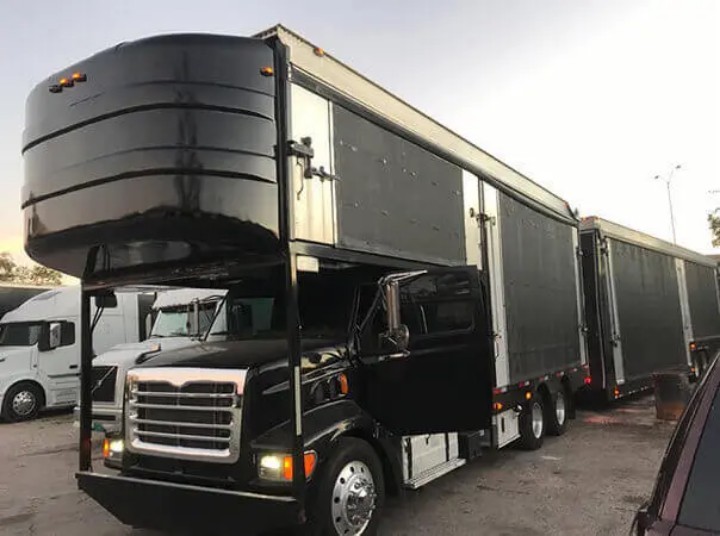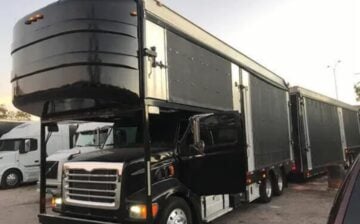
If you’re moving a long distance or internationally, you may need or desire to ship your vehicle. A professional auto transport company can move your car for you, so it arrives around the same time as you do and will be available at your new location.
Shipping your car saves you the effort and expense of driving. In some cases, it can save you money as well, when you factor in the cost of hotels, meals and gas, and wear and tear on your car.
You have different choices when shipping your car. One important choice is whether to use an open or enclosed car carrier. An enclosed car carrier typically can cost 40 to 60 percent more than an open carrier. But is it worth the cost?
This post will describe open and enclosed auto transport carriers and their differences. It will also list some things to consider when deciding whether to use an open or enclosed carrier. You may find this information useful before your next interstate or overseas move.
What Is an Open Carrier?
Open vehicle transport is the most common type of car transport. An open car carrier loads vehicles on a truck or trailer that is open on the sides. Each car may have some cover above it, but all are exposed on the sides. Cars carried on an open car transport are exposed to the elements: rain, snow, highway debris, dust, insects, and bird droppings. They are also more susceptible to theft and vandalism, and are less protected from damage in case of an accident. You may purchase auto transport insurance, but these policies usually come with deductibles and exclusions for things like hail and snow.
Besides being more affordable, open car transport is much more common, so it is easier to schedule. There are more trucks and drivers that do open transport than enclosed transport. Open auto carriers transport five to nine vehicles at a time, depending on the size of the vehicles. Ninety percent of car transports use open carriers.
What Is an Enclosed Carrier?
As the name implies, an enclosed auto carrier transports vehicles in an enclosed box with covers on the top and all four sides. Up to five vehicles are transported in an enclosed truck or trailer. The cars are protected from the elements and road hazards. They are also much harder to steal or vandalize, because they are not out in the open where thieves or vandals can get to them.
What Type of Carrier Do You Need?
Regardless of which type of carrier you choose, reputable auto transport companies take great care with their cars and work hard to keep them in good condition until they arrive at their destinations. The cars are carefully loaded and strapped in the carrier to minimize movement and vibration while the cars are on the road.
Many people erroneously believe covered auto transport is slower than open transport. Actually, the two types are similar in shipping time.
In fact, open auto transport may take longer because there are usually more vehicles being transported at the same time. Depending on the carrier’s schedule, your car may be the first to be delivered or the last. The last vehicle may be delivered up to a week later than the first. However, open carriers are much easier to schedule because there are many more of them. So you may be able to arrange shipping earlier on an open carrier than on an enclosed one.
Enclosed auto transport is more expensive: on average, enclosed auto transport costs $1,500, compared to $1,071 on average for open transport.
When Do You Need Enclosed Transport?
When would you want to pay the extra cost for enclosed auto transport? You might want to select this option if you’re transporting an antique, luxury or custom car and have an interest in keeping it in pristine condition. An enclosed auto transport offers peace of mind that you’ve taken every precaution to protect your valuable automobile from damage or theft during transport.
Enclosed carriers may also offer more insurance. Every auto transport company is required to carry insurance for possible damage to vehicles during transport. The minimum coverage for most carriers is around $350,000. In case of total loss, this amount is divided among the cars that were being transported. So, if your car was one of nine being carried, your insurance payout may be small, possibly not enough to cover the value of your car.
Because enclosed carriers have greater protection during shipping, the transport company might offer more insurance coverage. You might even find a transport company that will cover significant damage or total loss of a luxury vehicle.
If your vehicle has low ground clearance, you may also opt for enclosed transport. Many sports cars are designed to have low clearance. These vehicles are at greater risk of scraping on the ground or the metal deck of an open transport carrier while being loaded and unloaded.
Unlike the steep ramps of an open carrier, many enclosed carriers have platforms that lower to the ground to pick up the car, then lift it like an elevator to the carrier’s storage area. This eliminates the risk of the car’s undercarriage scraping on the ground.
Finally, if you’re shipping your car in winter, you might consider enclosed transport. Your car will be protected from subzero temperatures, snow, sleet and ice in an enclosed carrier.
Enclosed auto transport companies tend to specialize more in high-end vehicles or unusual cases than open carriers. If your car is longer than usual, like a limousine, or has aftermarket modifications like custom wheels, or is nonoperational, enclosed carriers are more likely to be equipped to handle it.
What Are the Different Types of Enclosed Carriers?
There are three types of enclosed auto carriers, depending on how many vehicles they can carry. Single-vehicle enclosed carriers can carry a single vehicle and are best suited for transporting high-end or antique cars. They are usually trailers and are used over short distances.
Single-level, multi-vehicle carriers can fit two to five vehicles and are used for either short or long distances. They take longer to load and unload than single-vehicle carriers but less time than multilevel carriers.
Multilevel enclosed vehicles can transport up to seven cars on two levels. These are often used for cross-country trips.
Enclosed carriers also differ in the type of siding they have. Hard-sided enclosed carriers usually have metal walls, typically steel or aluminum, and provide maximum protection for the cars they carry. Soft-sided enclosed carriers have vinyl side curtains that offer less shelter than hard-sided carriers but more than open carriers.
If you’re shipping your vehicle to your new home, you have a choice in the type of auto transport carrier you’ll use. If you bought your car used at a Honda dealer, chances are an open carrier will work just fine for you. But if you’re shipping a Ferrari in mint condition, you may want the added protection of an enclosed carrier. This post has given you some information to help you make the best choice for your situation.
We hope you found this post, Do You Really Need an Enclosed Car Carrier? useful. For more great information, see our post on How To Choose The Right Car Shipping Company.
Have Experience in the Moving Industry? Want an Additional Income Stream? Work With All Around Moving!
Partner with us, All Around Moving Services Company, Inc., and we’ll help you make money by establishing your own moving consultant business. Click here to learn more.





